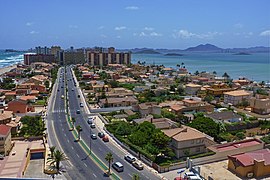Vallejar
Christian Community of Vallejar Comunidad Cristiana de Vallejar | |
|---|---|
Motto: Honor o Muerte ("Honor or Death") | |
Anthem: El Novio de la Muerte | |
| Capital | Alhama la Nueva |
| Largest city | Cartagena |
| Official languages | Spanish |
| Religion | Vallejar Christianity |
| Demonym(s) | Vallejarian Vallejarian |
| Government | Theocratic Monarchy |
• King/Queen off Vallejar | David II de Alhama la Nueva |
• Minister of God | Maximo Bueno |
| Legislature | Royal Palace |
| Establishment | |
• Approval of the first and only constitution | 1831 |
| Area | |
• Total | 913.411 km2 (352.670 sq mi) |
| Population | |
• Estimate | 34,500,000 |
• Census | 2032 |
| GDP (nominal) | estimate |
• Total | 1.173 Trillion |
• Per capita | $34,000 |
| Gini | 33.3 medium |
| HDI (2032) | 0.812 very high |
| Currency | Vallejarian Peseta (VPT) |
| Driving side | right |
| Calling code | +33 |
| Internet TLD | .va |
Vallejar, officially known as the Christian Community of Vallejar, is a nation located in the Vallos subcontinent. It shares borders with Takatta Loa and Castadilla, states with which it shares an indirect history, and is a member of the League of Nations. Covering an area of 913,411.107 square kilometers and with a population of approximately 34.5 million people, Vallejar is characterized by its motto "Honor or Death" and a strong sense of unity and commitment.
The capital of Vallejar is Alhama la Nueva, with Cartagena as its largest city. The official language is Spanish, and the predominant religion is Vallejarian Christianity, which holds significant influence in the country's political life.
Vallejar operates as a hereditary monarchy, and public education is highly valued as a means for personal development and national progress. The economy is diverse, with a growing focus on promoting renewable energy and environmental protection.
The country has a public healthcare system and a transportation infrastructure that includes roads, railways, national airports, and ports. Relations between minority religious groups and the official religion are generally respectful, with protection of religious freedom.
Etymology
The history of the Christian Community of Vallejar is characterized by a pivotal event that defined its identity as a nation. After a forced independence, the nation faced challenges in establishing itself as a structured entity and avoiding becoming a failed state. Two years after its independence, a popular referendum was held, which marked a turning point in its history.
This referendum allowed the entire population over the age of 16 to exercise their right to vote and make a momentous decision about the nation's future. The options at hand were the possibility of becoming a democratic state, in line with the majority of nations worldwide, or an absolute theocratic monarchy based on the nation's own religion. The result of this vote was overwhelming, with 97% in favor of establishing a theocratic monarchy.
Following this historic decision, the king, considered appointed by God and backed by the overwhelming will of the people, took a measure that completely transformed the nation. Vallejar, in accordance with its new theocratic identity, became the cradle of Vallejar Christianity. This religious determination became the foundation of the nation's identity and culture.
As a consequence of this significant change, Vallejar officially changed its name to the Christian Community of Vallejar. The influence of religion and the theocratic monarchy became the fundamental pillars of the nation, defining its path and values over time.
History
The history of the Christian Community of Vallejar has been a journey filled with political and military challenges. From its inception, the nation has experienced periods of turmoil and conflicts, both internal and external. However, despite these challenges, Vallejar has always maintained its commitment to its cultural and religious roots.
The people of Vallejar are characterized by being hardworking, persistent, humble, and respectful. They have always sought a better future and a more equitable world for all, regardless of the adversities they have faced throughout their history.
The nation has staunchly defended its theocratic identity and has been willing to fight for its beliefs and values. Despite the difficulties, the Christian Community of Vallejar has worked tirelessly for the prosperity of the kingdom and the fraternity among its citizens. This dedication to its core principles has been a key factor in its ability to overcome challenges throughout the centuries and to forge its own destiny as a nation.
Origin

(2500 B.C. to 1500 B.C.)
The "Origin" period in the region that would later become Vallejar, spanning from approximately 2500 B.C. to 1500 B.C., was marked by the migration and settlement of tribes and indigenous groups in different geographical areas. Each tribe occupied a specific territory and was organized into clans or families with shared blood and cultural ties. These tribes often set up their camps near water sources, providing them with access to vital resources and facilitating daily life.
The relationships between tribes varied considerably. Alliances were sometimes formed, and marital ties were established to strengthen cooperation between communities. However, there were also numerous conflicts and confrontations, largely due to competition for resources and regional power. These wars and struggles led to the disappearance of several indigenous tribes, along with their cultures and languages, marking the beginning of the decline of the original indigenous populations in the region.
The culture of this period was closely related to subsistence through hunting, fishing, and gathering. Religious beliefs were based on the veneration of nature and natural elements. Indigenous groups developed primitive technologies such as stone and wood tools, which allowed them to survive and thrive in their environment. Oral tradition played a fundamental role in transmitting knowledge about hunting, fishing, and gathering, as well as in preserving stories and myths that were a significant part of their cultural heritage.
- Ahanu
- B'alam
- Cuyahoga
- Dziko
- Echota
- Ruandos
- Gavran
- Hakan
- Ilyana
- Jirko
- Kaelith
- Lirael
- Maelis
- Naiya
- Orelia
- Pheonix
- Quillon
- Raelin
- Sylas
- Taryn
- Ulyssan
- Vaelar
- Tailpet
- Xylander
- Yavanna
- Zephyr
Perpetual Prosperity
(1500 B.C. to 33 A.C.)
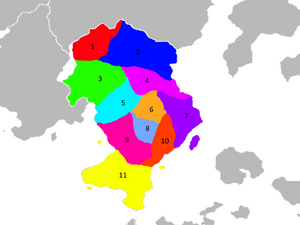
The period known as "Perpetual Prosperity" in the region that would later become Vallejar marked a significant transition in the history of this land. This era, spanning approximately 1,500 years, began with a traumatic event: the Tailpet Massacre. This massacre resulted in the complete disappearance of the native population in this region, leaving behind a void that would alter the course of history.
Despite the violence surrounding the Tailpet Massacre, this event led to a surprising consequence: peace. The atrocity shocked the surrounding tribes and prompted them to seek peaceful coexistence instead of perpetual violence. This change in focus paved the way for a period of peace that lasted for centuries and allowed for the region's prosperity.
With the reduction of conflicts and the establishment of peaceful relations, tribes could focus on economic and technological development. During this time, there was an unprecedented economic boom. Key technologies, such as the wheel and triennial cultivation, revolutionized the way tribes moved and produced food, which, in turn, encouraged trade and specialization in craftsmanship.
Tribes began to establish more organized governments to maintain peace and promote cooperation. Alliances and trade systems developed, contributing to the stability and prosperity of the region. Culture was enriched, and there was a significant improvement in the quality of life for the population.
Towards the end of this era, around 3 A.D., there are written records that speak of the appearance of "unknown foreign individuals". These people were not native to the region that the natives knew so well, marking the first signs of foreign influence in the area.
- Kingdom of Valoria
- Kingdom of Eldoria
- Kingdom of Sylvantia
- Kingdom of Marantha
- Kingdom of Husbuan
- Kingdom of Solaris
- Kingdom of Kuckter
- Kingdom of Emberlund
- Kingdom of Aquilonia
- Kingdom of Celestria
- Kingdom of Sumania
Premature Medieval
(33 B.C. - 572 A.D.):

The period of the "Premature Medieval" in what would later become Vallejar witnessed a series of significant changes. It began around 33 B.C., marking the end of the "Perpetual Prosperity." During this stage, the region experienced a consolidation of power and the formation of stronger and more organized states.
Territorial fragmentation resulted in the creation of various types of political entities, from absolute monarchies to tribal states in the northern region. These states were separated both geographically and mentally, mainly due to deep religious differences that emerged. While the weak but organized monarchies vied for control in the south, the tribal states in the north were considered pagan and, therefore, religious enemies.
Religion played a fundamental role in shaping politics and conflicts during this period. The population, mostly descendants of the powerful Ruandos tribe of Romance ethnicity, was divided among different religious beliefs. This religious division largely separated the territories and prevented unity and collaboration in the region.
Foreign influence also played a significant role in fragmenting the population into different territories. As the period progressed, constructions and infrastructure consisted mainly of dirt roads, small villages, and minimally fortified cities. As the population focused on consolidating states and religious disputes, the development of technology slowed down as little importance was given to technological advancement.
During this time, adventurers from across the known world began arriving on the shores and royal courts of the region's kingdoms, anticipating the age of discoveries to come. Foreign influence became increasingly evident, setting the stage for future events that would shape Vallejar's history.
The three most important kingdoms that vied for power during this period were the Kingdom of Husbuan, Kurckter, and Sumania. Although there was no clear winner, Sumania emerged as the most powerful state by the end of the stage, laying the foundations for Vallejar's future.
- Kingdom of Valoria
- Kingdom of Eldoria
- Kingdom of Sylvantia
- Kingdom of Marantha
- Kingdom of Husbuan
- Kingdom of Kuckter
- Kingdom of Sumania
Medieval Era
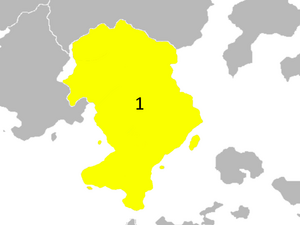
(572 A.D. - 1492 A.D.):
The "Medieval Era" in Vallejar extended from 572 A.D., marking the end of the "Premature Medieval," to 1492 A.D., when Pelaxian pioneers arrived in the region. This period in Vallejar's history witnessed events that would have a lasting impact on the region.
One of the most notable events during this time was the gradual absorption of other kingdoms by the Kingdom of Sumania. By around 980 A.D., Sumania had successfully integrated the populations of other kingdoms, creating a strong union and brotherhood that prevailed over any other belief or personal identity, whether within the kingdom or in the external realm.
The prosperity of Sumania during this period was such that the kingdom embarked on a holy war against tribal and barbarian states in the vicinity. These wars were successful, further strengthening the kingdom and consolidating its power in the region.
On a technological level, like most states in the Middle Ages, technological advancement stagnated. However, there were advancements in other areas, such as architecture. Human structures took on a unique architecture influenced by the native population's culture. Important political, economic, and social centers were fortified as the region became more hostile.
During this time, more serious diplomatic contacts were also established with other organized, independent, and sovereign states. These contacts laid the groundwork for future relations and agreements.
By the mid-year 1492, the first 106 Pelaxians arrived in the region with the intention of finding new lands to conquer on behalf of their kingdom. This event would mark a turning point in Vallejar's history as the arrival of the Pelaxians opened new perspectives and challenges for the region.
- Holy Kingdom of Sumania
Colonial Era
(1492 A.D. - 1818 A.D.):
The "Colonial Era" of Vallejar began in 1492 A.D. with the arrival of Pelaxian pioneers in the region. From the start, the Pelaxians were friendly and excited to have found new lands, especially discovering a civilization across the sea. The weary and sick sailors were welcomed into the royal palace of the Kingdom of Sumania, where they received medical care and rest.
After recovering, the sailors engaged in conversations with the King of Sumania and revealed that they were seeking new lands to conquer on behalf of the Kingdom of Pelaxia and its monarchs, Reginaldo Castrillón and Jerónimo De Pardo. Although it was agreed that the Sumanian lands would be respected, within less than a year, around 27,000 Pelaxian conquerors arrived on the Sumanian shores. The large number of Pelaxians, their technological superiority, and the lack of organization among the Sumanian troops allowed the conquest of Sumania in less than three years. This brief war was termed the "Religious Conquest of Sumania" as it was given a religious connotation to justify the war.
The Sumanian population underwent multiple attempts at assimilation, including peaceful conversions, ethnic genocide, and negotiations with local leaders. However, the inability to assimilate the population led the territory to become a colony producing raw materials and precious metals, which were sent to the metropolis.
Throughout the colonial era, there were constant conflicts between the native population and the conquerors. For over three centuries, the repression of native ethnicities and their original cultures was an everyday feature in the colony.
Colonization also brought influences from abroad, with the most notable being the introduction of Christianity into the territory. The adaptation of local religious values led to the formation of a new religion, now known as Cristiandad Vallejar. By 1800, the religion was spreading considerably and beginning to be widely practiced.
However, Pelaxian authorities, viewing the growing popularity of the new religion with suspicion, took harsh measures to suppress it. This repression sparked a popular uprising starting in 1815, gaining strength throughout 1816 and 1817, culminating in the declaration of independence in 1818 with the "Declaration of Independence of Revolutionary Alhama". Pelaxia's response was to declare war on the "rebel territory," marking the beginning of the struggle for Vallejar's independence.
Independence War
(1818 A.D. - 1829 A.D.):
The period of the "War of Independence" in the region known as Vallejar extended from 1818 A.D. to 1829 A.D. It was a crucial and decisive phase in the region's history, marked by the revolutionaries' struggle for Vallejar's independence from Pelaxia.
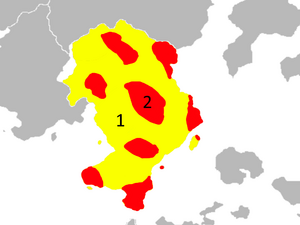
After the declaration of independence in 1818, Pelaxia responded by declaring war on the newly independent territory. This armed conflict was an attempt by the revolutionaries to secure Vallejar's freedom and sovereignty against the Pelaxian metropolis. Throughout this war, the Vallejarian population fought with great determination and courage for their emancipation.
Battles and conflicts were fought across the entire territory of Vallejar, with revolutionaries coming together in a joint effort to resist the Pelaxian occupation and defend their newly acquired independence. The conflict was long and challenging, with moments of great sacrifice and suffering.
The War of Independence was an unequal struggle, as the revolutionaries, while determined, lacked the same technological and strategic advantages that Pelaxia possessed. However, determination and belief in their cause propelled the revolutionaries to fight tenaciously.
Throughout the war, there were several attempts at peace by Pelaxia, offering conditions that would allow for continued Pelaxian influence in Vallejar. These peace offers were presented in 1824, 1825, and 1827. In 1824, a return to a colonial status was proposed. In 1825, a colony with greater freedoms was offered, and in 1827, the creation of an autonomous state under Pelaxia's rule was suggested. However, the revolutionaries rejected all these offers, insisting on their pursuit of full independence.
Finally, in 1829, after nearly 11 years of struggle, the revolutionaries achieved victory in the War of Independence. Pelaxia recognized Vallejar's independence, marking the birth of a sovereign and free nation. The independence treaty was signed in the town of Vallejar, which became a symbol of Vallejar's struggle for freedom. The bloodiest battle of the war was fought in this town, where 32,000 revolutionaries faced 57,000 Pelaxians. Despite the difficulties, the Vallejarians defended their position on top of a sacred mountain for the natives for over 13 hours. The battle came at a high cost in lives, with 5,600 casualties among the revolutionaries and 23,900 among the Pelaxians. This town and battle became a symbol of the fight for freedom and gave its name to the newly emerged independent state, which became known as Vallejar.
- "Rebel State"
- Areas occupied by Pelaxian forces
Independence and Sovereignty
(1829 A.D. to Actuality)
The era of independence and sovereignty in Vallejar, which extends from 1829 AD to the present day. The beginning of this era was marked by the freedom of the Vallearian people, who finally had the autonomy to determine their own path and destiny. In just two years, the first Constitution of Vallejar was approved, and a monarch was named, laying the foundations of the nation.
The integration of Vallejar into the Loa Empire with the sign the Vallejarian peaceful integration in Loa Empire treaty, which took place from 1829 until the dissolution of the empire in 1875, was a period marked by an unexpected union that significantly changed the destiny of the Vallejarian nation. Following Vallejar's forced independence from Pelaxia, the Loa Empire presented itself as an unusual yet appealing alternative. Despite the somewhat unstable government situation in the Loa Empire in the 1830s, it offered Vallejar a friendly integration into its territories, ensuring the complete freedom of the Vallejarian people in exchange for close collaboration with the imperial government. Although the integration seemed to imply Vallejar becoming part of the Loa Empire, in practice, the territory of Vallejar retained its independence. During this period, which lasted until the empire's fall in 1875, Vallejar was able to benefit from this relationship in many ways. Close collaboration allowed Vallejar to access Loa technology and modernity, which propelled the country's development. A robust trade relationship was established with neighboring Polynesian kingdoms, improving Vallejar's economy and regional influence. Furthermore, this period of unity and collaboration led to a blending of cultures and peoples, creating a more diverse and enriched society. The protection provided by the Loa Empire in the early years of national sovereignty also contributed to the security and stability of Vallejar.
One of the first decisions made by the appointed monarch was to change the name of the nation to the Christian Community of Vallejar, proclaiming the state as the defender and promoter of Vallejarian Christianity. This emphasized the importance of religion in the life and culture of the nation. Religious freedom became a fundamental right, and Vallearian Christianity became one of the key pillars of the kingdom.
The freedom obtained during this era also drove significant advances in technology and other fields. Vallejar began to develop a diversified economy and promote research and innovation in various sectors. This contributed to the growth and prosperity of the country in the decades that followed.
Throughout this period, Vallejar has continued to progress, maintaining its core identity and values, including its commitment to religion, education, and environmental protection. The nation has continued to evolve as a modern and diverse society while holding a deep respect for its history and heritage.
Geography
-
Gran puerto de Cartagena
-
Sierra Espuña
-
Embalse de la Cierva
-
Erosiones de Bolnuevo
-
La manga
-
Mar Menor
The Christian Community of Vallejar is characterized by its picturesque and diverse geography. Much of its territory consists of extensive plains, fertile farmland, and gentle mountains that house many of the nation's historical structures and buildings. Additionally, Vallejar's geography is marked by the presence of unusual mountain peaks that act as natural barriers between different administrative zones.
Vallejar's moderate climate and the presence of small but abundant rivers have contributed to the lush vegetation that characterizes the region. The nation also benefits from its coastal location, providing access to the sea, facilitating navigation and maritime trade at any time. This combination of geographical factors has made Vallejar an ideal place for agriculture and a naturally beautiful environment.
The geographical diversity of Vallejar has given rise to a wide variety of landscapes that are appreciated by both local residents and tourists. Beautiful places to visit and available tours have attracted both international and domestic tourism, turning the most scenic areas into popular destinations. This tourism industry not only highlights the nation's natural beauty but also contributes to economic development, as areas with greater tourist appeal are often slightly more prosperous than the rest of the country.
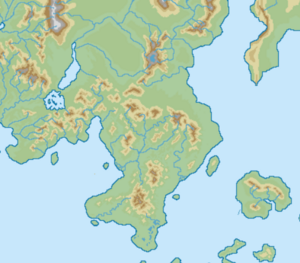
Climate and environment
The climate of the Christian Community of Vallejar is characterized by its moderation in terms of temperatures, making it a pleasant place to live and engage in activities throughout the year. Temperatures range from a cool 3°C in the coldest times to a warm 36°C on the hottest days. Most of the time, there is a slightly warm climate that provides a sense of calm and comfort.
In terms of meteorology, Vallejar experiences rainfall that, while not very abundant, is frequent throughout the year. Approximately, it is estimated that 12 days of each month are rainy, which helps to maintain the green and prosperous landscape. During the colder seasons, the nation can experience strong winds that can reach up to 100 km/h at their peak. In higher elevations, snowfall can persist throughout the winter season, adding a picturesque touch to the region.
Overall, the sky in Vallejar is often clear with radiant sunshine unless there is inclement weather. This moderate and varied climate is ideal for the development of normal and everyday activities for the population, contributing to the quality of life for residents and fostering an environment conducive to the nation's prosperity.
Government and Politics
The Christian Community of Vallejar has a system of government based on absolute theocratic monarchy. Under this system, the king holds absolute power and is the supreme ruler of the nation, making decisions in consultation with his ministers of God and advisers whom he appoints himself. This government is an expression of the deep relationship between religion and the state in Vallejar.
To facilitate the efficient administration of the nation, Vallejar is divided into five administrative zones, which are treated as entities with equal rights and laws. These regions, while equal in terms of rights and laws, are intended to streamline the management of each geographical area.
This government structure reflects the importance of monarchical and religious authority in the life of the Christian Community of Vallejar, where stability and cohesion of the nation are fundamental to its identity and functioning.
Executive
Under the system of absolute theocratic monarchy in the Christian Community of Vallejar, executive authority is shared between God and the king, who rules in accordance with divine will. The king is considered the lord of all and serves as the intermediary between God and the nation's legislative power. This role grants him supreme authority to make decisions on behalf of the nation and ensure that the religious and moral tenets of Vallejar's Christian faith are followed.
The idea that the king governs in accordance with the will of God is fundamental in the nation's system of government, and it is expected that all of the king's decisions are guided by this belief. This reinforces the importance of religion and spirituality in the life of the nation and the influence of the Christian faith in governmental decision-making.
To improve the administration of the different areas, the government is organized into ministries headed by the different ministers of God, these ministrys are: Security and Justice, Defense, Education, Economy, Healtcare, Infrastructure, Interior, foreign relations and society.
Legislative
Under the system of absolute autocratic monarchy in the Christian Community of Vallejar, the responsibility for the legislative power rests with the king, who makes decisions in consultation with his ministers of God and advisers whom he appoints. However, it's important to note that, while the ministers and advisers provide counsel to the monarch, they do not have the ability to interfere in the king's final decision. The monarch is the supreme authority in legislative decision-making, and ultimately, his decisions are definitive.
This governmental structure reflects the centralized authority and power of the king in the Christian Community of Vallejar, where individual decision-making is highly valued, often in alignment with religious principles and the will of God. Ministers of God and advisers play a supportive role to the king but do not have direct influence on the monarch's final decision.
In the Christian Community of Vallejar, there are no political parties due to the absence of democratic elections. Instead, the nation operates under a system where legally recognized representative organizations play a crucial role. These organizations act as advocates for the ideas and needs of the people, presenting them to the king through a meticulous legal process. This approach ensures that the voices of the people are heard and considered in government decisions.
Regarding monarchical succession, the country follows the model of medieval monarchies. The head of state is transmitted through family inheritance, where the king's eldest child inherits the realm. In situations where there is no suitable heir available, or if there is no suitable royal member to assume the position, legal processes are carried out to determine a new ruler or a solution to the nation's governance. This approach ensures continuity and stability in monarchical succession while allowing for some flexibility to adapt to changing circumstances.
Additionally, the current monarch has the power to exclude certain members from the line of succession if deemed necessary. This authority provides an important tool to maintain stability in the country's leadership, ensuring that those who assume the head of state are well-prepared to carry out their responsibilities.
Administrative Zones
The Christian Community of Vallejar is characterized by its focus on equality and non-discrimination among its citizens. There are no distinctions based on race, origin, economic status, social situation, ethnicity, or culture. The nation values unity and equality among all its inhabitants and promotes an inclusive environment where each individual is treated with respect and fairness.
The divisions that exist in the country are purely administrative and are used to improve and expedite legal procedures in each region or zone. There are no real barriers or borders between these administrative zones, and freedom of movement between them is unrestricted. Tax and legal conditions are uniform throughout the country, unless explicitly stated otherwise.
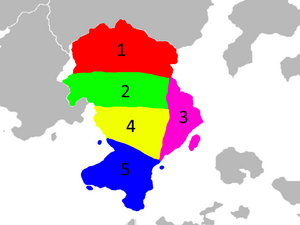
The nation's five administrative zones are San Gabriel, Santa Lucía, Monteclaro, Valle Verde, and Los Picos. Although the capital, which houses the king and the royal family in the Alhama la Nueva Palace, plays a central role in terms of politics and administration, it does not receive preferential treatment compared to other cities in the country. The emphasis is on equality and equity for all citizens, regardless of where they reside or work, promoting an inclusive and just society in the Christian Community of Vallejar.
- San Gabriel
- Santa Lucía
- Monteclaro
- Valle verde
- Los Picos
- Gran Chimborazo (Special administrative zone, Does not appear on the map)
Politics
The Christian Community of Vallejar presents a political landscape characterized by the presence of various political organizations. The vast majority of these organizations have the primary goal of altruistically improving the state. It's important to note that none of these political organizations receive state subsidies.
These political organizations strive to present proposals and solutions that can contribute to the progress and well-being of the nation. Their focus lies in identifying and addressing issues that are not always directly observed by the state or the rulers, thereby seeking to enhance the quality of life for citizens and the efficiency of public administration.
This political dynamic reflects the commitment of Vallejarian society to actively participate in the improvement and development of the nation, demonstrating a genuine concern for the welfare and progress of their country. The absence of state subsidies to these organizations underscores their independence and altruistic focus in the pursuit of solutions and improvements for the Christian Community of Vallejar.
Law
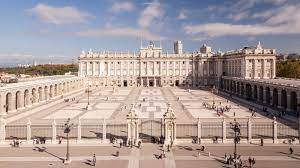
The Christian Community of Vallejar has a unique system of governance in which there are no political parties due to the absence of democratic elections. Instead, legally recognized representative organizations play a fundamental role by serving as vehicles for the presentation of the people's ideas and needs to the king through a legal process.
Regarding succession to the throne, the system is based on family inheritance, following a tradition similar to medieval monarchies. The king's eldest child inherits the kingdom, maintaining the continuity of the head of state within the same bloodline. However, in situations where there is no suitable royal member to assume the position, legal processes are carried out to determine a new ruler or a solution to the nation's governance. This approach highlights the importance of continuity and stability in the monarchical succession.
Furthermore, the current monarch has the authority to make decisions regarding who is included in the line of succession, allowing for some flexibility in the designation of heirs. This system of governance reflects a balance between tradition and adaptation to changing circumstances, ensuring that the nation continues to function effectively and in accordance with its values and beliefs.
In the Christian Community of Vallejar, the legal system is intrinsically linked to religion and its values. All the laws of the nation are based on the ethical and moral principles of the predominant religion, ensuring that no law contradicts these fundamental values. This legal approach aims to enable all citizens to understand and relate to the religion professed by the nation and how it is reflected in the administration of the country.
The Constitution of Vallejar is a fundamental part of its legal system and serves as a central legal framework. Unlike other laws, the Constitution is subject to popular vote, and it is only approved if more than 80% of voters support it. This reflects the importance placed on the Constitution's approval by the majority of the population, ensuring that it serves as a strong foundation for governance and society in Vallejar.
In summary, the laws in the Christian Community of Vallejar are rooted in religion and its moral values, and the Constitution is one of the few laws subject to popular vote, ensuring a high degree of support from the population.
Demographics
The Christian Community of Vallejar is distinguished by being a state that values and supports diversity, as long as it aligns with the nation's ethical values. Openness to people of different cultures, religions, backgrounds, and socioeconomic situations, as long as they share the desire to live in peace, contribute, and assimilate into the existing population, is a fundamental pillar of the country's immigration policy.
This attitude embraces and encourages cultural and ethnic diversity in Vallejar, creating an environment where tolerance and coexistence are paramount. Despite this policy of openness and welcoming diversity, the recent history of the nation has hindered significant immigration to the country, which may be due to specific circumstances or policies that have limited the flow of immigrants in recent times.
This balance between promoting diversity and recent limitations on immigration reflects the complexity of Vallejar's immigration policy and its commitment to ethical values and social cohesion.
| Population | Amount | Percentage |
|---|---|---|
| Children | Aprox 8.97 Mill | 24% |
| Adults/Working Class | Aprox 21.39 Mill | 62% |
| Seniors/Retirees | Aprox 4.83 Mill | 14% |
Ethnicity
The Christian Community of Vallejar takes pride in being a state that promotes diversity and inclusion, as long as the ethical values of the nation are respected. In Vallejar, all individuals are valued, regardless of their culture, religion, origin, socioeconomic status, and other aspects. Those who wish to live in peace, positively contribute to society, and assimilate into the existing population are welcomed in the country.
This policy of inclusion and openness has resulted in a diverse society rich in terms of experiences and backgrounds. Vallejar celebrates tolerance and coexistence among people of different origins and beliefs, fostering an environment where diversity is considered a strength.
The combination of an inclusive approach and recent restrictions reflects the complexity of Vallejar's immigration policy and its commitment to ethical values and social cohesion.
Language
The Christian Community of Vallejar has Spanish as its only official language and the most widely used language in everyday life, in professional and educational settings. However, the state recognizes and values the personal use of native languages and other languages commonly used by immigrants. In addition to Spanish, there are several languages spoken in the familial and closer circles of the Vallejarian population. These languages may include Uabel and Latin (the language from which Spanish originated), among others.
Historically, Vallejar has been home to various native cultures and communities, each with its own language and cultural heritage. However, the native language considered the "parent" of the nation's native languages was lost with the last village abandoned by the Naluera tribe. The lack of written records in this language made its preservation and in-depth understanding difficult, leading to the loss of the culture and history of this native population. This lost language was exclusive to the region that now constitutes Vallejar, but there are also other less widely spoken native languages in the region, shared with neighboring states.
The linguistic diversity in Vallejar reflects its rich cultural heritage and the influence of various communities throughout its history. Although Spanish is the primary language in the country, recognition and respect for other languages and cultures contribute to the richness and diversity of the nation.
Religion
Religious affiliations in Vallejar (2031)
In the Christian Community of Vallejar, religion plays a central role in political decision-making, with the predominant religion being Vallejarian Christianity. The nation's strong religious tradition has led to the integration of Vallejarian Christianity into all government bodies and certain parts of the administration. Freedom of worship in the state is a fundamental right and is recognized and respected througho ut the country, reflecting the religious values that form the basis of all politics in Vallejar.
Additionally, Islam is the second most widely practiced and abundant religion in Vallejar, reflecting the religious diversity of the nation. While Vallejarian Christianity is the predominant religion and plays a significant role in the nation's life, Islam also has a significant presence and is respected in Vallejarian society. Freedom of worship and respect for religious diversity are essential aspects of coexistence and politics in the nation.
Education
Education in the Christian Community of Vallejar is characterized as public and promotes a critical approach to religion. In public schools, students are encouraged to think for themselves and question ideas, contributing to their personal, professional, and technological development in the nation, recognizing that young people are the future of the kingdom.
Literacy and education indicators in Vallejar are notable, with 98% of the population capable of reading and writing normally. 97% of the population has completed compulsory primary education, 86% have reached compulsory secondary education, 63% hold a high school diploma, and 40% have obtained higher education degrees in various fields and possible degrees.
The commitment to education is evident in the allocation of a significant budget to the education sector. The nation recognizes the vital importance of education both in its development and its religious foundations, which emphasize that the progress and prosperity of the nation depend largely on education.
This focus on education as a cornerstone of progress and the commitment to the formation of future generations reflects the importance of education in the Christian Community of Vallejar.
Culture and Society
The population of the Christian Community of Vallejar is characterized by its simplicity and humility. Vallejarians value and enjoy the blessings of life, making the most of the experiences it offers. The religious foundations of the country have instilled an approach to life that does not seek materialism or personal extravagance but values experiences and human relationships.
Furthermore, in the current context where the nation faces challenges and difficult situations, citizens have shown an unwavering commitment to set aside personal motivations and come together in a collective effort to rebuild and improve the country in all necessary aspects. This collaboration is based on the values of effort and hard work promoted by the religion practiced in Vallejarian society.
Collectively, these values of simplicity, humility, solidarity, and effort have forged a united and committed community in the Christian Community of Vallejar, where the experience of life is cherished, and efforts are made together to achieve a better future.
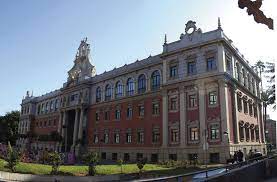
Education
The education system in the Christian Community of Vallejar is uniform throughout the kingdom, with a clear focus on quality and equity in education. The different parts of the country follow a standardized curriculum structure, consisting of three stages:
- Infant and Primary: During this stage, children are taught to communicate, write, and develop basic mathematical skills. The main goal is to provide the necessary foundations for the next educational level, which is secondary education.
- Secondary: In this stage, subjects are taught to prepare students for higher education. In addition to acquiring knowledge, a spirit of hard work, effort, and responsibility is fostered. Critical and analytical thinking is also promoted, preparing young people for future academic and professional challenges.
- Higher Education: In this phase, specific training is provided in various professional fields. The duration of programs varies depending on the chosen career and course. Schools, institutes, and universities are independent institutions, but they operate under the current education law. Despite this, they have some autonomy to conduct competitions, trips, extra classes, and other activities to enhance the quality of education in their centers. All secondary schools and universities also have student and faculty representation groups that work together to improve their respective institutions. In addition, there are educational organizations that can make proposals to the government with the aim of improving education in general.
Public education is widely supported by the Vallejarian population, as it is considered a means for the personal development of young people and the progress of the nation as a whole. Additionally, the education system focuses on promoting brotherhood and solidarity among citizens, a value highly cherished by the majority of the population. In summary, public education is a source of pride and unity in the Christian Community of Vallejar.
Attitudes and worldview
Humility is the most cherished value among the population of the Christian Community of Vallejar, and this focus on modesty and simplicity deeply influences how citizens view life. While religion provides guidance, it does not limit individual interpretations, allowing each person to construct their own meaning and purpose in life.
This focus on humility and respect for individual perspectives results in a diverse society where each individual can express their opinions and beliefs more or less elaborately compared to others, or simply choose to see life from different viewpoints. Despite these differences, shared values among the population, including the pursuit of peace and tranquility, are unifying and bring harmony to the vast majority of the nation.
In summary, humility and openness to diverse perspectives are prominent features of life in the Christian Community of Vallejar, and these qualities contribute to peace and peaceful coexistence in society.
Kinship and family
In the Christian Community of Vallejar, families are mostly structured according to the "traditional family" model. However, it's important to note that Vallejarian society is characterized by a deep respect for personal choices and the diversity of ways to love, regardless of a person's sexuality. The nation values and promotes equality and respect for all individuals within the legal boundaries established by the penal code and civil code of Vallejar.
This means that while the "traditional family" model is predominant, the existence of various family structures and personal relationships in Vallejarian society is recognized and respected. The values of equality and respect for all individuals are fundamental in the Christian Community of Vallejar, contributing to an environment of inclusion and acceptance of diversity in all its forms.

Cuisine
The cuisine of Vallejar is a fusion of influences, where local ingredients blend with foods brought from abroad during the conquest and colonization of the territory, that is why Vallejarian cuisine is similar to Pelaxian cuisine. This interaction between external factors and the introduction of new crops unknown to the natives has given rise to a diverse and delicious culinary tradition that can be experienced in almost every kitchen in Vallejar.
The diversity of unique dishes and flavors found in Vallejar is the result of centuries of cultural influence and exchange. From traditional dishes that use indigenous ingredients to recipes that incorporate elements from other parts of the world, Vallejar's cuisine reflects its history and diversity. The flavors, aromas, and colors of Vallejarian gastronomy are a testament to the culinary richness of the nation.
Religion
In Vallejar, religion is a fundamental and highly significant element for the population. The predominant religion in the country is Vallejaran Christianity, which has historically been a pillar of the culture and society. The majority of citizens are followers of this religion and consider it a central aspect of their identity and values. Vallejaran Christianity is an essential part of daily life and the way people understand their purpose in the world.
This religion is not only important for individual life but also influences government policies and decisions. Vallejaran Christianity is considered the official state religion and plays a prominent role in shaping laws and policies. The government recognizes and respects the right to free worship, meaning that citizens have the freedom to practice their religion without restrictions.
Regarding minority religious groups, Vallejar is a country that promotes religious tolerance and respect for different beliefs. While Vallejaran Christianity is predominant, there are religious minorities, such as the Islamic community, which are also protected by the law and enjoy the freedom to practice their faith.
The relationship between the predominant faith and minority religious groups is generally harmonious, as Vallejar's culture promotes peaceful coexistence and mutual respect. The majority of the population values religious diversity and sees it as an opportunity to enrich society. The country's laws are designed to protect and ensure religious freedom for all citizens, regardless of their faith.
Arts and Literature

Art in Vallejar is characterized by its simple style, resembling realism but deeply rooted in the mentality and culture of the people. Most of the artworks that follow this style today are paintings and architecture. However, in earlier times, religious sculptures could also be found in monasteries and churches throughout the nation. These archaeological remnants indicate that Vallejar's cultural history is rich and ancient, allowing art to evolve and develop over time.
Despite cultural evolution and the passage of centuries, the fundamental artistic style of Vallejar has remained largely unchanged. This style could be named "Vallejarian Realism" in recognition of its simplicity and its deep cultural and historical roots in the country. The connection between art and the mindset of Vallejar's citizens has resulted in a unique and enduring artistic tradition that remains an integral part of the cultural identity of the nation.
It is interesting to observe how literature in Vallejar has played a crucial role since the early days of colonization, driven by the need to spread religion and facilitate the assimilation of the native population. Over the years, significant literary works reflecting religious influence and the way of life in the nation have emerged. Here, I present two fictional works that exemplify this influence:
- "The Paths of Eternal Faith": This work, written by Federico García Lorka, narrates the story of a spiritual journey in search of religious truth and redemption. Through the experiences and dilemmas of the characters, the novel explores the importance of faith in the lives of Vallejar's citizens and how religion has shaped their society.
- "The Song of Redemption": This is a poetic epic that celebrates Vallejar's devotion and spirituality. The work recounts the hero's struggle for salvation and redemption in a world filled with challenges and temptations. The poem was writen by Antonio Manchado, and reflects the profound connection between faith and everyday life in Vallejar and how religion has been a source of inspiration for citizens throughout history.

Sports
In Vallejar, sports play a prominent role at the national level, with football, basketball, and tennis being the most important sports. These sports have leagues and various categories and are widely followed by the population. Furthermore, a large portion of the citizens seeks relaxation, enjoyment, and fun by playing one of these sports on weekends.
It is evident that the majority of professional athletes aspire to represent their country in the national team, achieve titles, and take pride in their victories for the nation. This strong sense of patriotism is deeply ingrained in the population and is reflected in their support for national teams and their passion for sports.
Sports are not only a form of entertainment in Vallejar but also a source of unity and national pride. Sporting successes are celebrated throughout the country and contribute to strengthening the sense of identity and belonging to the nation.
Symbols
In Vallejar, besides the national flag, there are no other symbols that represent the kingdom. The flag has become the unifying symbol of the nation and represents all citizens without distinction. This symbolic choice aims to promote peace and coexistence among the citizens, fostering the idea that everyone is brothers and sisters sharing a common national identity. The flag has become a powerful symbol of unity in Vallejar, contributing to strengthening the bonds among its inhabitants and reinforcing the sense of belonging to the nation.
Economy and Infrastructure
The economy in Vallejar is diverse and well-balanced. The nation's economic engine is based on both heavy and light industries, with significant contributions from the agricultural sector and technological companies. Vallejar excels in the production and advancement of industrial technologies, driving its continued economic growth. While the growth is not explosive, the country's economy continues to expand steadily.
This economic sustainability is partly due to the mindset of Vallejar's population, which values hard work, effort, and perseverance as means to improve their circumstances. The focus on industry and technological innovation has contributed to the country's consistent growth, in turn strengthening its position on the international economic stage.
Industries and Sectors
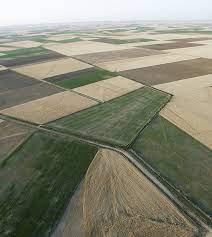
The most important economic sectors in Vallejar include:
- Industry: Industry is one of the main drivers of Vallejar's economy. It encompasses both heavy and light industry, including the manufacturing of goods, machinery, electronic equipment, chemicals, and more. The industry is a fundamental pillar of the economy and provides a wide range of jobs in the country.
- Agriculture: Agriculture remains a crucial sector in Vallejar, with the production of various crops such as cereals, fruits, vegetables, wine, and olive oil. Additionally, livestock farming and fishing are also significant components of the agricultural economy. Agricultural production is both for domestic consumption and export.
- Technology and Innovation: While Vallejar has been working on expanding its technology sector, technology and innovation are growing in importance in the economy. The country is looking to boost research and development and promote investment in technology and startups. This includes the production of green and sustainable technologies.
- Tourism: Vallejar has seen growth in the tourism industry in recent years. The country's natural beauty, historical and cultural heritage, as well as its focus on sustainability, attract tourists from around the world. Tourism significantly contributes to the economy, generating income through hospitality, restaurants, transportation, and other related activities.
- Renewable Energy: Vallejar has made significant investments in renewable energy, including solar, wind, and nuclear energy. The country aims to reduce its dependence on fossil fuels and transition to cleaner and more sustainable energy sources. The production and export of technology and equipment related to renewable energy are also significant aspects.
These economic sectors are vital for Vallejar's development and economic growth, and the country continues to work on their expansion and diversification to ensure a prosperous and sustainable economic future.
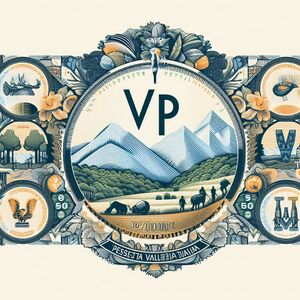
Currency
The official currency of Vallejar is the Vallejarian peseta (VPT). The adoption of this currency was done with the purpose of asserting greater independence from other nations and highlighting the strength of the country. In addition to the peseta, Vallejar accepts foreign currencies under the supervision and regulation of the country's fiscal authorities. This flexibility in accepting foreign currencies contributes to Vallejar's international economic relations and facilitates international trade.
Healthcare
Healthcare in Vallejar is entirely public and funded through taxes. It is a sector of great importance to the nation, and both the population and the government are committed to ensuring it is of high quality and excellence. It is guaranteed that healthcare professionals have access to all the necessary resources and facilities to carry out their tasks effectively. The medical infrastructure includes general hospitals, specialized hospitals, health centers (for smaller populations), and clinics of various types. This allows citizens to access a wide range of medical services and healthcare throughout the country.
Labor
In Vallejar, workers' organizations are independent of the government, and traditional labor unions do not exist. Instead, legal labor organizations are encouraged, where workers can voluntarily and altruistically join. These organizations do not receive external funding but are sustained through contributions from the workers themselves. Their main goal is to allow workers to express their concerns, grievances, and proposals related to their work experiences. This structure promotes open and participatory dialogue between workers and their employers, contributing to a more harmonious and collaborative work environment in the nation.
Transportation
Transport infrastructure in Vallejar is managed, built, and maintained by the government. Currently, the conditions of the land transportation infrastructure are considered average, as the state has more pressing priorities at the moment. However, the country has a network of national airports that facilitate the transportation of goods and people quickly and efficiently.
Given that Vallejar is made up of a group of islands within its sovereign territory, ferry transportation systems have been developed to allow mobility between the different islands. Additionally, the nation has important ports that play a crucial role in trade and the country's economy.
Despite its size, Vallejar also has international airports, although they are relatively few. These airports have an international character and play a fundamental role in receiving tourists, immigration, and interacting with delegations and visitors from other countries. This international openness reflects Vallejar's commitment to freedom of movement and cultural exchange.
Energy
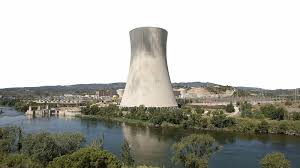
Vallejar, in its firm commitment to environmental preservation and sustainability, has led a remarkable revolution in its energy sector. The nation has taken a determined stance toward renewable energy sources, becoming a global leader in the responsible use of natural resources. The majority of energy in Vallejar comes from renewable sources, such as solar panels and wind stations, harnessing the power of the sun and wind to meet the country's energy needs.
Furthermore, Vallejar has taken a bold step by incorporating nuclear energy into its energy infrastructure, with careful regulation and safety measures. This move has been approached with caution and rigor, with a focus on safety and innovation to ensure that it is used responsibly and in an environmentally-friendly manner.
This commitment to renewable energy is not only based on the understanding that nature provides inexhaustible resources but also on the firm belief that minimizing pollution is essential to allow the ecosystem to regenerate and thrive. Vallejar has not only phased out polluting energy sources like coal, natural gas, and oil but has also actively promoted research and development of green technologies.
Technology
Vallejar has maintained a continuously evolving technological level over the years, although it is currently classified as a country with a medium level of technology. The nation has faced internal challenges that have hindered the full development of its technological capabilities, as well as limitations in terms of investment in research and development.
That being said, Vallejar has been pragmatic in its approach to technology and has established fruitful relationships with neighboring countries and international organizations to import the necessary technology to meet its current demands. This strategy has allowed Vallejar to stay up to date in terms of innovation and make progress in key areas, albeit with certain limitations.
Despite the challenges, Vallejar has demonstrated a strong commitment to improving its technological level in the coming months and years. The country is expected to take significant steps towards the adoption of cutting-edge technologies and investment in research and development to promote innovation. With its track record of resilience and forward-looking vision, Vallejar is well positioned to elevate its technological status and continue to thrive on the international stage.
Military

The Vallejarian military has played a crucial role in the nation's history and has remained one of the most advanced and respected sectors. With a long military tradition dating back to imperial times, Vallejar's armed forces have historically been a source of pride for the population. During its rich history, they have participated in countless conflicts and battles, with many distinguished generals, such as Don Juan Casanova, Lucas Faso Gutiérrez, or Ramiro Parlo Jota, who have left their mark on the country's military history.
Today, the Vallejaran military is a comprehensive and modern institution. It is composed of various specialized divisions in all fields and is equipped with state-of-the-art technology. In addition to its traditional role in defense and security, the armed forces also play a significant role in civil protection and maintaining secure borders. Religion and state policies have influenced the development and strength of the military, leading to a broad, well-trained, disciplined body of specialists in various areas.
Structural composition
The Vallejarian Army is composed of four distinct sections, each further subdivided into various units or military departments. This organizational structure is designed to enhance the administration of the military sector, and the army operates within the military laws of the nation, internal regulations of its sections, and even regulations of its departments if such exist. The army is administered by the Ministry of Defense, responsible for all matters related to military development and affairs. The Supreme Commander, in addition to section generals, is the king, holding complete authority over the army and serving as the primary icon alongside the flag.
Ground Forces
The Ground Forces are the oldest military branch established in Vallejarian territory, originating as a professional force in the early 16th century under the governor of the newly conquered territory by Pelaxian forces. Initially, small militias comprised of local men-at-arms, needy peasants, mercenaries, and Pelaxians seeking a living in the New World formed the foundation. Their initial mission was to maintain Pelaxian control over the region without maintaining a professional army on the territory.
These local militias gradually organized, grew, and formalized, forming different militia divisions with various objectives scattered throughout the territory. The main militias during the colonial era were the Monteclaro Militia (main militia for maintaining control over important areas), the Lightning Militia (rapid-response militia for urgent and significant threats), and the High Fort Militia (heavy militias guarding borders against land attacks, especially from "barbarians").
After more than a century of maintaining control over the area, the militias were unified into a single military entity known as "The Host of Vallejar" (named after the place of its creation). This Host was part of the Royal Hosts of Pelaxia, considered the best of their time, and their dominance on the battlefield was overwhelming. This Host, formed in the town of Vallejar, had the same function as its predecessors: ensuring Pelaxian control of the territory against any threat.
This section is divided into four specific departments:
Border Control: This department is responsible for the security and maintenance of the nation's land borders to prevent illegal immigration, drug trafficking, entry of dangerous individuals, and terrorists, among other things. It is composed of land border forces and posts, as well as the management of these resources.
Citizen Security: The Citizen Security department is tasked with ensuring citizen security at important events, large gatherings, and for the protection of important personalities.
General Army: This is the main department, composed of all land forces and vehicles owned by the Vallejarian government. Its function is to defend the integrity, sovereignty, and national security, as well as the constitutional order of Vallejar.
Development of Military Technologies (Land): This department is responsible for developing technologies related to the ground forces and their mechanized components to improve the effectiveness of land forces.
The Vallejarian Navy was established in 1835, six years after the War of Independence. During the colonial era, all military and commercial ships and vessels were entirely integrated into the Pelaxian navy. After independence and the complete reconstruction of the state from scratch, the army and navy were professionally and modernly rebuilt. Revolutionaries with military experience were formalized and professionalized, all vessels were repaired and rebuilt, and military departments were created for army management.
This section is divided into four specific departments:
Maritime Control: Responsible for the control of seas where Vallejarian sovereignty is effective, focusing on repelling threats, patrolling, and alerting the general navy in case of urgent and immediate danger. It also controls illegal immigration, drug trafficking, and the overall control of the seas, consisting of armed boats and small ships.
General Navy: The main force of the navy, tasked with defending Vallejar's sovereignty and maritime control against any significant threat. It also supports ground units when necessary and assists the air forces. This section includes all military vessels owned by the Vallejarian government not assigned to other sections.
Protection of Vessels: Dedicated to protecting and supporting all national vessels that require protection due to the nature of their content, importance, or circumstances. This protection service is free for all national vessels requiring it and has worldwide reach. Foreign vessels in similar circumstances can also request protection, but it will only be provided in the Vallos region and will be free of charge. It consists of different armed boats and medium-sized ships.
Development of Military Technology (Navy): Comprising scientists, researchers, and engineers dedicated to developing military technologies related to the navy. This section has research centers throughout the territory, both public and private.
Air Force:
Established in 1923, the Vallejarian Air Force is dedicated to maintaining control and national sovereignty over Vallejar's airspace, as well as conducting various missions, deliveries, and test flights to experiment and aid in the sector's development.
This section is divided into three specific departments:
Air Control: Ensures the civil aviation safety of Vallejar, monitoring all Vallejarian airspace and its surroundings. Using advanced surveillance systems, it anticipates potential threats, ensuring an effective response in emergency situations. Additionally, it collaborates with civilian authorities to coordinate flights and ensure safe and efficient air traffic. This department includes all control centers and air traffic controllers overseeing airspace, along with general aviation and its quick-response aircraft.
General Aviation: The most critical part of Vallejarian aviation, consisting of all military aircraft owned by the Vallejarian government. It is responsible for maintaining national air sovereignty, supporting and assisting other sections as needed.
Development of Military Technology (Aviation): This department develops military technologies for aviation to advance the sector technologically. It consists of research centers, scientists, and engineers.
Space Force
The Vallejarian Space Force, established in 2005 is focus on defending, maintaining, and expanding national sovereignty beyond the atmosphere.
This section is divided into three specific departments:
Logistics and Intelligence: Manages the construction and launch of military and civilian satellites for the nation, focusing on intelligence and logistical support.
Space Operations: The most important department of the Space Force, dedicated to conquering and maintaining superiority in deep space. Comprising all ships, satellites, and various probes and national objects launched beyond the atmosphere, also collaborates closely in the national space program.
Development of Military Technology (Space): This department aims to develop and improve space technologies for both military and general national use. It includes research and development centers throughout the nation, along with scientists, engineers, and researchers. the most ambitious objective is to achieve spacecraft with stable nuclear propulsion for long distances and trips, in addition to improving their efficiency, speed and safety.
See also:
· Pelaxia





